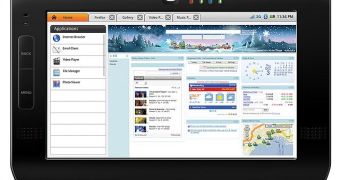Freescale recently unveiled a new tablet reference design meant to fully leverage the full spectrum of performance capabilities of the ARM processors. New smartbooks will provide instant-on functionality, improved connectivity and longer battery life. The design is the first in the Smart Application Blueprint for Rapid Engineering (SABRE) series from Freescale and will be demonstrated at the 2010 Consumer Electronics Show. The new devices based on this design are expected to be capable of an all-day battery life.
“Freescale’s new tablet opens the door to an exciting new world of compelling form factors specifically designed and optimized to support common online activities including social media, high-quality audio/video playback and light gaming,” Henri Richard, senior vice president of Sales and Marketing for Freescale, said. “We believe the tablet will emerge as a popular form factor for the next generation of smartbooks. By introducing this prototype reference design, Freescale intends to play a vital role in propelling the mainstream adoption of smartbooks.”
The form factor will enable long-lived devices about a third in size compared with typical netbooks and with 7-inch touch-screens whose viewing area is four times larger than that of smartphones. The SABRE was designed based, partly, on feedback from an end-user research study jointly conducted with the Industrial Design program from the Savannah College of Art and Design.
The new tablet design measures 200mm x 128mm x 14.9cm and weighs 376 grams. It is built with the ARM Cortex-A8 core, OpenVG & OpenGL/ES graphics cores and HD video decoder hardware. Additional specs include 512MB of DDR2 and an internal storage of 4 to 64 GB with a removable micro SD. The 7-inch display with touch capabilities has a maximum resolution of 1024 x 600. In addition, the new smartbooks will be equipped with backlight drivers for displays and keypads, as well as with RGB LED drivers.
The connectivity of the new design includes an optional 3G modem, 802.11 b/g/n, Bluetooth 2.1, GPS and optional RF4CE. Furthermore, the input/output options of the new smartbooks will include one USB 2.0 and a USB mini port, audio in/out, outputs for speakers and microphone and an SIM card. The device will be wall- and USB-chargeable.
Further capabilities of the new smartbook design include boost converters for LCD backlighting, a 3-Mpixel camera (video recording of up to VGA 30fps), as well as an MMA8450Q 3-axis accelerometer and an ambient light sensor.
“Semiconductor providers looking to differentiate in the nascent tablet market will need to offer solutions-focused system reference designs if they are to succeed with the world’s foremost consumer electronics OEMs,” Jeff Orr, senior mobile devices analyst at ABI Research, added. “There is clearly strong end-user demand for tablet form-factors, and new reference designs look to play a major role in helping OEMs speed tablet smartbook products to market.”
The CES will see the technology demonstrated on both the Android and the Linux operating systems. The smartbook reference design itself is fully detailed here and is expected to become available during February at prices even lower than $200.

 14 DAY TRIAL //
14 DAY TRIAL //